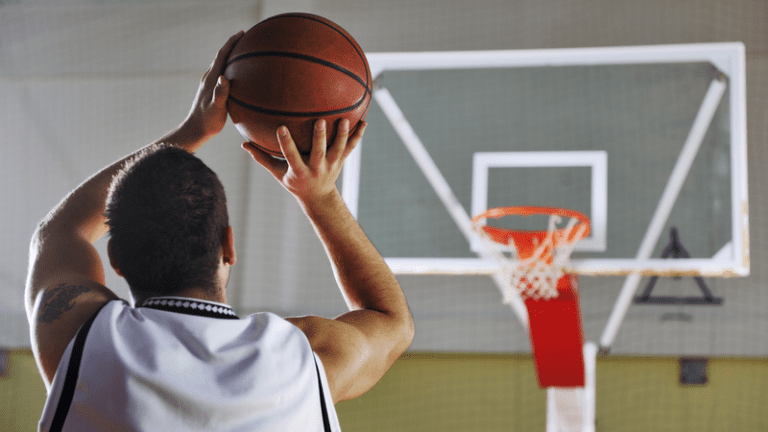Shooters have two simple tasks, shooting straight and judging distance. This means that if one misses left or right, one is not shooting straight. If one misses short or long, one is not judging distance properly. Common flaws cause these types of misses and can be easily corrected.
Players at all levels have shooting flaws, yet have succeeded because of superior athleticism and depth perception. Yet, they are streaky shooters, rather than consistent ones. Eliminating common flaws can make a good shooter consistently good.
Missing left or right tends to be caused by one or both of two very common flaws.
The most common shooting flaw is the use of the non-shooting hand to help propel the ball.
Shooting with two hands causes the ball to be pushed a bit sideways in the shooting hand. The shooting hand may or may not compensate for that. If it does, it cannot do so the very same every time. The sideways push of the off hand will cause shots to miss to the left or right. Another significant flaw is found in a diagonal line of the shooting forearm, more commonly noted as the flying elbow (elbow out). When the line of the forearm is not straight, the ball cannot go straight, unless the shooting hand compensates somehow. Again, this cannot be done consistently well.
Correcting two-handed shooting means making the off hand separate from the ball just before the ball is released. A training aid that is very effective is the Star Shooter strap. Correcting the forearm problem involves making it a habit to start the shot with the ball in front of the biceps on the shooting arm.
The primary reason that shots are missed long involves the bend of the elbow during the lift of the shot.
When the shot begins and as it lifts, the elbow should be at a 90-degree angle until it naturally extends to straight. We call this the “L.” The “L” must not pinch into a “V”. The “V” is the primary reason for missing long. Another way to recognize the presence of a “V” is when the ball comes closer to the shooter’s face in the lift. The “V” is a major part of the two-motion lift, which robs the shooter of some strength and flattens out the arc. Traditional, yet faulty reasoning says that missing long means that a shooter has put too much power in from the legs. Too little leg power is by far the more common lower-body flaw.
Missing short can come from either a grip problem or a follow-through problem. Gripping the ball on the fingertips causes the ball to roll off the fingers too soon and with too little control. A shooting-hand thumb that flicks under the palm is a typical reason for this. The ball should sit on the length of the fingers at the beginning of the grip. Two different, but common follow-through problems can also leave shots short. Hands that drop too soon can be corrected by freezing the follow through in place with elbow above the eyebrow until the ball contacts the basket. Another follow-through problem that leads to missing short is called string pulling. We see the shooting arm recoil back instead of locking straight at the elbow. String pulling often happens with the two-motion (“V”) shot. Those need to be addressed together.
Bob Topp
Shot Doctor Basketball Shooting Coach
Annapolis (MD) Area Christian School
————————————————————————
CoachUp is the safest and easiest way to find a coach for personalized training. With our 100% money-back guarantee and vetted coaches, anyone can achieve their full athletic potential. Find your perfect coach today and become the athlete you want to be!
How useful was this post?
Click on a star to rate it!
Average rating 3 / 5. Vote count: 2
No votes so far! Be the first to rate this post.



One Response
Do you think I need to adjust my daughter’s form if she is double jointed/hyper mobile at the elbow?